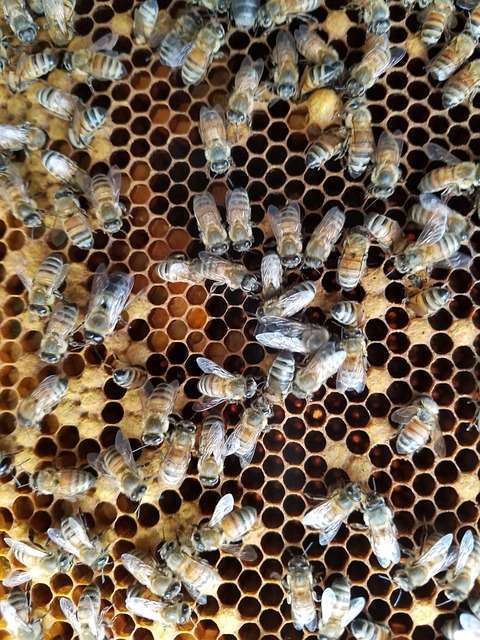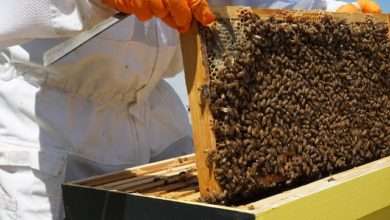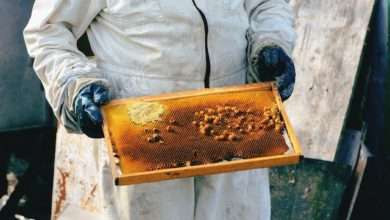The Importance of Water for Honey Bees: A Vital Resource for Their Survival

Honey bees are essential to our planet’s health, and they are a critical link in our food chain. But how exactly do they survive? One of the key components that keeps these hardworking insects healthy and thriving is water.
In this article, we will explore the crucial role that water plays in the lives of honey bees and why their health can no longer be taken for granted. We will also discuss why proper hydration is so important for bee colonies and why beekeepers should take the time to provide adequate resources for their colonies.
The Water Needs of Honey Bees
Here, we will explore the importance of staying hydrated, the water intake process, and how bees collect water from various sources.
Hydration: Quenching the Thirst
One might wonder, why is hydration so crucial for honey bees? The answer lies in the fact that water is vital for various aspects of a bee’s life, from maintaining body temperature to digestion and food processing. Let’s take a closer look at the importance of staying hydrated for honey bees’ overall health and functioning.
Importance of Staying Hydrated:
Proper hydration is essential for honey bee colonies to thrive and fulfill their duties within the hive. Bees rely on water to cool down the hive during hot weather, dilute honey for feeding larvae, and maintain a suitable humidity level for brood development. Without ample access to water, bees would struggle to perform these critical tasks, ultimately jeopardizing the colony’s survival.
The Water Intake Process:
Now that we understand the significance of water for honey bees, let’s delve into how they quench their thirst. Unlike mammals, bees do not possess a drinking apparatus like a mouth or a throat. Instead, they have evolved a unique method to collect water efficiently.
- Water Sources: Bees gather water from a variety of sources, ranging from natural bodies of water such as ponds, streams, and puddles to artificial sources like birdbaths and water troughs. They may also visit damp soil or vegetation, as these can provide moisture necessary for their hydration.
- Collection Mechanism: To collect water, bees employ a process called water collection or water foraging. Worker bees, which are responsible for this task, leave the hive to scout for suitable water sources. Once they locate a viable water source, they transport the water back to the hive in a specialized organ called a “crop.” The crop is essentially a honey bee’s internal water storage tank, allowing them to carry a significant amount of water back to the hive.
- Sharing the Water: Upon returning to the hive, worker bees regurgitate the collected water from their crops into cells within the hive. This sharing of water ensures all bees within the colony have access to this life-sustaining resource when needed.
Cooling the Hive:
During hot weather, honey bees employ a clever technique to control the temperature inside their hive and prevent it from reaching potentially dangerous levels. The process of water evaporation plays a crucial role in this cooling mechanism.
- Regulating Hive Temperature: To regulate hive temperature, honey bees collect water from various sources such as ponds, puddles, or streams. They bring the water back to the hive, where it serves as a means of cooling down the whole colony. Honey bees have an impressive ability to manipulate water droplets within their hive.
- Evaporative Cooling: Evaporative cooling is the primary mechanism employed by honey bees for maintaining optimal hive conditions during hot weather. Worker bees carefully distribute water droplets throughout the hive by spreading them on the walls and combs. As these water droplets evaporate, they absorb heat from the surroundings, effectively reducing the hive’s temperature.
- Dilution of Honey: Apart from regulating temperature, honey bees also use water to dilute honey for feeding their young brood. This practice serves multiple purposes and offers numerous benefits to the colony.
Diluting Honey for Brood Feeding:
Honey bees collect nectar from flowers and convert it into honey by adding enzymes and reducing its water content. However, honey in its concentrated form is unsuitable for feeding the brood, as it may be too dense and difficult to consume. To overcome this, honey bees add water to their stored honey, effectively diluting it to the appropriate consistency for feeding their growing larvae.
Benefits and Reasons behind Dilution:
Diluting honey not only makes it more accessible for the brood to consume but also provides them with an essential source of hydration. Additionally, watering down honey helps in the maintenance of proper hive humidity levels, as excess moisture from the dilution process contributes to a favorable environment for the colony’s development.
Sources of Water for Honey Bees
Bees use water for various purposes such as hydration, temperature regulation, and honey production.
- Natural sources
Rivers, lakes, and puddles
In nature, honey bees have access to various natural water sources, including rivers, lakes, and puddles. These bodies of water are vital for bees, especially during hot and dry weather conditions when water becomes scarce.
Bees collect water from these sources using their tongues and store it in specialized honey stomachs called crops. They then transport the water back to their hives to meet the needs of the colony.
Importance of clean and shallow water sources
Clean and shallow water sources are of utmost importance for honey bees’ safety. Bees are excellent flyers but are not strong swimmers. Therefore, they prefer water sources that are easily accessible and shallow, allowing them to land and gather water without the risk of drowning.
Clean water is crucial to prevent the spread of diseases within the hive, as contaminated water sources can become breeding grounds for harmful bacteria and parasites.

- Human-made water sources
Necessity in urban and agricultural areas
In urban and agricultural areas, natural water sources for honey bees may be limited or contaminated due to human activities. It is essential for beekeepers and individuals to provide alternative water sources to support honey bee populations.
Urban areas often lack natural bodies of water, making it crucial to create artificial water stations to ensure bees have access to the water they require. In agricultural areas, pesticides and fertilizers used in farming can contaminate natural water sources, making it necessary to provide safe alternatives for bees.
Creating safe water stations for honey bees
To support honey bees in urban and agricultural areas, individuals can take practical steps to create safe water stations. Here are some suggestions:
- Birdbaths or shallow containers: Place shallow containers filled with clean water in your garden or nearby green spaces. Be sure to add some rocks or floating platforms for bees to perch on while collecting water.
- Dripping water source: Set up a dripping water source by suspending a water-filled container with a small hole above a shallow basin. The constant dripping of water will attract bees to quench their thirst.
- Avoid chemical use: Ensure that the water provided for bees is free from any chemicals or contaminants. Avoid using herbicides, pesticides, or cleaning products near the water stations to prevent harm to the bees.
- Regular maintenance: Keep the water stations clean and replenish them frequently to prevent stagnant water. Stagnant water can attract unwanted pests and mosquitoes, posing a threat to bees.
Challenges and Risks
- Scarcity and Accessibility:
1. Challenges in Finding Sufficient Water Sources:
Honey bees require water not only for hydration but also for tasks within the hive, such as nest building and temperature regulation.
However, in many areas, finding an adequate supply of water can be a daily struggle for these remarkable insects. Factors like climate, geography, and seasonal changes can impact the availability of water sources, limiting the accessibility for honey bees.
2. Impact of Scarcity and Competition:
When water is scarce, honey bees face intense competition amongst themselves, as well as with other insects and animals that also rely on water. This competition can lead to aggressive behavior and increased energy expenditure, affecting the overall health and vitality of the colony.
Foraging bees may have to travel longer distances in search of suitable water sources, which can be physically demanding and reduce their available foraging time.
- Pollution and Contamination:
1. Risks Associated with Polluted Water Sources:
Unfortunately, honey bees increasingly encounter water sources polluted by human activities. Pesticides, chemical runoff from agricultural fields, and industrial pollutants find their way into natural water bodies, compromising the quality of available water sources for honey bees.
This pollution poses a severe threat to the health of honey bees, impacting their immune systems, navigation abilities, and reproductive capacities.
2. Negative Consequences of Contaminated Water for Honey Bee Colonies:
When honey bees collect water from contaminated sources, they inadvertently bring harmful substances back to their colonies. The contaminated water can contaminate the hive, causing long-term damage and negatively influencing honey bee larvae, adult bees, and the overall hive population.
Pesticides and pollutants can weaken the bees’ immune system, making them more susceptible to diseases and parasites, ultimately leading to colony collapse disorder.
Supporting Honey Bees’ Water Needs
Now, we will explore different ways to support honey bees’ water needs, ensuring they have ample access to this vital resource.
Gardening Practices
- Encouraging Pollinator-Friendly Gardening: To enhance water availability for honey bees in your vicinity, it is essential to promote pollinator-friendly gardening practices. By adopting these methods, you can create a haven for bees to gather water conveniently.
- Highlighting the Role of Water-Rich Flowers: Planting water-rich flowers in your garden serves as an excellent source of hydration for honey bees. Flowers such as lavender, asters, sunflowers, and bee balm not only provide nectar but also contain water droplets on their petals, which bees readily consume. By including these flowers in your garden, you can support honey bees’ water needs naturally.
- Providing Water-Retaining Elements: In addition to water-rich flowers, consider incorporating water-retaining elements into your garden design. Shallow bird baths, small ponds, or even strategically placed water-holding rocks can allow honey bees easy access to water. These elements also double as attractive garden features while fulfilling the bees’ water requirements.
Creating Water Stations
Offering Simple Ideas for Water Stations: Setting up safe and bee-friendly water stations can significantly help meet honey bees’ water needs. Here are some easy-to-implement ideas:
- Bee Water Fountain: Create a shallow water basin using a shallow dish or container and fill it with clean water. Place small stones or objects within the basin to provide bees with a surface to land on while they drink.
- Drip System: Set up a slow-drip system by using a container with a small hole at the bottom. Fill the container with water and hang it upside down near your garden. The steady, slow drips will attract bees while preventing the formation of stagnant water.
- Sponges and Wet Sand: Place wet sponges or provide an area with damp sand that honey bees can land on and extract moisture from. This simple yet effective method ensures bees have access to water without the risk of drowning.
Cleanliness and Freshness:
Maintaining the cleanliness and freshness of water sources is of utmost importance when supporting honey bees’ water needs. Bees are more attracted to clean water, and standing water can quickly become a breeding ground for disease-carrying mosquitoes. Regularly inspect the water stations, refill them with fresh water, and clean them to ensure the health and well-being of the bees.
Conclusion
Water is essential to honey bee health and it plays an important role in their nutrition, temperature regulation, and flight efficiency. Without access to adequate water sources, bees may become dehydrated and suffer from a range of health issues.
Therefore, beekeepers must ensure that their bees have access to clean water sources in order to keep their colonies healthy and thriving.
FAQ’s
Why is water important for honey bees?
- Water is vital for honey bees as it plays a crucial role in maintaining their overall health and survival. Bees need water for various essential activities, such as hydration, regulating hive humidity, cooling the hive during hot weather, and diluting honey stores for feeding the larvae.
How often do honey bees require water?
- Honey bees need a constant and accessible water source throughout the year. During periods of high activity, such as spring and summer, bees may visit water sources multiple times in a day to meet their hydration needs.
How far can honey bees forage for water?

- Honey bees typically forage for water within a 3-mile radius from their hive, although they may travel further if necessary.
- It is crucial to have water sources available within their foraging range to prevent bees from seeking water in alternative, potentially unsuitable places like swimming pools or birdbaths.
What is the best way to provide water for honey bees?
- Providing a dedicated water source for honey bees is essential. This can be accomplished by filling a shallow basin or birdbath with fresh water and adding floating objects such as cork pieces, rocks, or twigs for bees to land on while they collect water. This prevents drownings and provides a safe water source for them.
How can water sources be made more bee-friendly?
- To make water sources more bee-friendly, consider adding small rocks or marbles to the basin to provide shallow areas for bees to stand and collect water without risk of drowning.
- Additionally, placing the water source in a partly shaded area can help prevent water evaporation and maintain a suitable temperature for bees.
Are there any specific timeframes when honey bees need water the most?
- Honey bees require water throughout the year; however, during hot summer months, their water requirements increase significantly for maintaining hive temperature and cooling. Ensure a constant water source is available during these times to support their hydration needs.
Can honey bees use any type of water source?
- While honey bees can utilize various water sources, it is important to provide clean, freshwater. Standing water sources should be regularly refreshed or replaced to prevent the growth of algae or bacteria, which can be harmful to bees.
How do honey bees collect water?
- Honey bees collect water from various sources such as puddles, streams, lakes, and even dew on plants. They use their tongues to lap up the water, store it in their honey stomachs, and transport it back to the hive.
Are there any precautions to take when providing water for honey bees?
- When providing water for honey bees, avoid using chemical pesticides or insecticides in the surrounding area, as these can contaminate water and harm the bees. Additionally, ensure the water source is easily accessible and avoid creating deep water bodies that may pose a drowning hazard.
Can I use chlorine-treated tap water for honey bees?
- It is best to avoid using water treated with chlorine for honey bees. Chlorine can be harmful to bees, disrupting their delicate internal systems and potentially impacting hive health. If tap water is your only option, letting it sit uncovered for 24 hours allows chlorine to evaporate, making it safer for bees.
What are the signs of water stress in honey bees?
- Water-stressed bees may exhibit certain behaviors such as congregating around water sources, searching for alternative water sources in inappropriate places, or becoming less active within the hive due to dehydration. Recognizing these signs can help address water needs promptly.
Do bees need water in winter?
- While honey bees generally require less water during winter due to reduced activity, they still need access to water for hydration. Bees cluster together inside the hive during cold weather, and they utilize stored water reserves to maintain optimal humidity levels within the hive.
Can water scarcity affect honey bee populations?
- Yes, water scarcity can have a negative impact on honey bee populations. Without access to sufficient water, bees may become dehydrated and weakened, making them more susceptible to diseases and other stressors. Adequate water sources are vital for maintaining healthy bee colonies.




